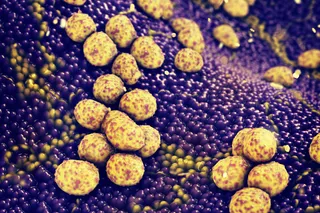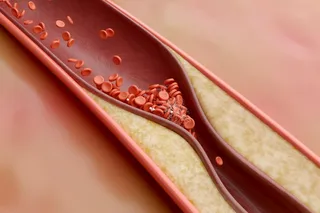I was in Tripoli, Libya, wiping sweat off my forehead. Sitting across from me in a back room of the Bulgarian embassy was a doctor named Zdravko Georgiev. In 1999, he and his wife, a nurse, had been arrested along with four other Bulgarian nurses and a Palestinian medical intern. They had been charged with bioterrorism, accused of intentionally infecting more than 400 children at a Libyan hospital with HIV. Georgiev, who had been working for a company on the other side of the country, had been released a few months earlier after having spent four years in prison, but the other medical workers, later dubbed the Tripoli Six, were waiting for death by firing squad.
It was a few days before Christmas three years ago, and it wasn’t hot—the Libyan capital is pleasant in December. I was sweating because Georgiev was describing what the Libyan police had done to him and the rest of the medics. The doctor was clearly uncomfortable recalling these events, speaking through parched lips and kneading his hands like bread dough. So I did my best to appear calm and professional; I focused on the irrelevant notes I scribbled in my spiral notebook as he described beatings, rape, electrocutions, and other tortures.
I remember standing up and suggesting that I open the window for some air. Then time stumbled, and I found myself on my back on the embassy carpet. Georgiev had pulled my knees up and tucked them under his chest. He held a stethoscope under my shirt. His face was inches from mine.
“Your heartbeat was below 40,” he said in his thick Slavic accent. “Not very good.” Georgiev was transformed. He looked decades younger suddenly, alert and alive, in his element once again.
“Good thing there was a doctor in the house,” I said, rising on one elbow.
Georgiev didn’t get the joke. “You remind me very much of my son,” he said. “Stay down.”
Before I was driven back to my hotel in one of the embassy’s black SUVs, Georgiev turned the tables and asked me a question. “Do you believe me, that we are innocent?” There is only one way to describe the look in his eyes at that moment: intense and desperate conviction.
I saw the same look the next day when I met with some of the Libyan parents. “We do not know why the medical workers did this, but we do know that they infected our children, that they are guilty,” said Ramadan al-Faitore, a Libyan engineer who quit his job to devote himself full-time to the case against Georgiev and the rest of the medics. These fathers chain-smoking in a shabby hotel room looked no less miserable than Georgiev, nor any less convinced.
If ever there was a job for science, this was it. Here was a case in which people needed to set aside their passions and prejudices, launch a fair investigation of the hospital outbreak, and reach a consensus based on the best evidence. And it did start out that way. Within months of realizing there had been a massive HIV outbreak at the al-Fateh Children’s Hospital in Benghazi, the Libyan government turned to the World Health Organization (WHO) for help. WHO experts arrived in Libya in December 1998 and stayed for two weeks, inspecting the hospital and interviewing the medical staff.
All evidence pointed to an accidental outbreak due to poor hygiene throughout the hospital. Not only was there a dire shortage of basic supplies, like plastic containers for discarded syringes, latex gloves, and autoclaves—a kind of pressure cooker for sterilizing equipment that is the cornerstone of safe microbiological technique—but standard procedures at the hospital also made viral cross infections inevitable. The staff were using intravenous catheters for injections in all children and then using the same syringes without sterilizing them. And sure enough, blood samples from the Libyan children were found to contain not only HIV but also several strains of hepatitis, a textbook indicator of widespread hospital infections caused by unsanitary conditions.
If such an outbreak had occurred in Europe, the results of the WHO assessment would almost certainly have been made public. But according to Kevin De Cock, director of HIV/AIDS at the WHO, “sharing such reports is usually at the discretion of the government.” The Libyans kept the WHO report secret (it has since been leaked). What happened next reveals the danger of not ensuring transparency in public-health disasters.
Early in 1999, the police secretly arrested numerous people they believed were involved with the infection at the Benghazi hospital, including a Palestinian medical intern, Ashraf al-Hadjudj, and five Bulgarian nurses, Nasya Nenova, Valya Chervenyashka, Snezhana Dimitrova, Valentina Siropulo, and Kristiana Valcheva. Georgiev was arrested as well when he desperately asked the Libyan police for information about his missing wife. It wasn’t until 2000 that they were charged with a crime. The seven foreigners stood accused of deliberately sparking an AIDS epidemic with the aim of attacking the security of the state. If found guilty, the penalty was death. Why would the medical workers do such a thing? An answer came in April 2001 when Libya’s longtime dictator, Colonel Muammar al-Qaddafi, spoke at an HIV/AIDS summit in Nigeria. The colonel went off-script and told the assembled press and world leaders about “an odious crime” committed at a Libyan children’s hospital. A devastating new form of the HIV virus had been created in a laboratory, he said, and a group of foreign medics “carried out an experiment on these children.” The authorities had not been able to stop the experiment in time, but at least they had captured the perpetrators. Qaddafi said he wasn’t sure who had fomented the plot, but he named the American CIA and the Israeli Mossad intelligence services as the top suspects.
The courtroom drama that followed was Kafkaesque. The prosecution presented evidence of the medics confessing to the crime. (They later claimed they were tortured into confessing.) In return, the prosecution said, for large sums of money provided by shady figures known as “John the Englishman” and “Adel the Egyptian,” the medical workers had systematically injected the man-made virus into the children’s veins. The medics were depicted as living extravagant lifestyles with their ill-gotten wealth, consuming alcohol in public and indulging in extramarital sexual intercourse, both of which are illegal in Libya. The smoking gun, exhibited with much fanfare, was a vial that the police claimed to have found at the home of one of the nurses. Libyan experts told the court that they had performed tests on residues that proved that it contained HIV.
In September 2002, the phone rang in immunologist Vittorio Colizzi’s office at Tor Vergata University in Rome. Upon finding that his old friend microbiologist Luc Montagnier was calling from Paris, Colizzi launched merrily into French with the same Italian accent that laces his English. But it was immediately clear that this was urgent business rather than a friendly chat. Montagnier wanted to know if Colizzi would be willing to travel to Libya. It seemed that the Libyans were reaching out for help—or at least Qaddafi’s son and presumed successor, Seif al-Islam, seemed to be doing so. Al-Islam had contacted Montagnier, leader of one of the first teams to isolate the HIV virus in 1983, through the Libyan ambassador to Unesco in Paris. He was asking for an independent group of European scientists to study the HIV outbreak in Benghazi and reach their own conclusion about how it had originated and spread. Montagnier asked Colizzi to lead the Libyan investigation.
Colizzi landed in Tripoli three months later, in January 2003. He began by assembling a timeline of the outbreak. At first, the hospital officials balked, but Colizzi finally obtained spreadsheets of the clinical records and discovered amazing exculpatory information. At least a dozen of the infected children hadn’t visited the hospital since 1997, some of them not since 1994—long before March 1998, when the accused medics started working there. As if that weren’t proof enough of innocence, a newborn became infected at the hospital months after the medics were arrested: The outbreak had continued after the alleged culprits were removed from the scene of the crime.
When Colizzi mentioned these facts, hospital officials claimed they were errors in the record. A new version of the hospital records was produced, this one with the children’s treatment dates all falling neatly within the period of employment of the accused medics.
Colizzi also asked to see the so-called smoking gun, the glass vial found at one of the nurses’ homes. Libyan technicians had analyzed residue within the vial using a technique called a Western blot, a quick and dirty probe for the presence of particular antibody proteins—in this case, ones that bind to HIV. “They showed their result in the courtroom,” he says, “and it just looked like background noise. It was not a positive result at all.” Even if it had been positive, it would have indicated only that the vials had contained blood from someone exposed to the virus. A far more sensitive test using polymerase chain reaction could prove whether the HIV virus itself was present in the vials. “We offered to do this test, but the court never gave us access to the vials.”
And the claim that the virus was created in a CIA laboratory was “a complete misunderstanding by the Libyans,” according to Colizzi. As is typical of newly isolated HIV viruses from Africa, the sequences did not match any HIV sequence then available on GenBank, the online database of genetic sequences maintained by the U.S. National Institutes of Health. The report’s use of the word “recombined,” which in this context refers to naturally occurring recombination of DNA, was taken by the Libyans to mean that the virus was created in the laboratory.
On May 6, 2004, it seemed that the Libyan affair was finally near its end. Colizzi and Montagnier had testified as independent scientific experts, carefully explained the evidence exonerating the medics, and submitted a report that summarized their findings. But then a group of Libyan doctors presented a critique. “It was like a bad joke,” recalls Colizzi. According to Colizzi, the Libyan assessment was riddled with basic misunderstandings of molecular biology. They dismissed (pdf) both Colizzi and Montagnier’s report (pdf) (they said it was unscientific) and the medics’ claim of having been tortured: The medical examination of the victims had not followed “correct procedure” and therefore should not be considered by the court.
To the shock of Colizzi and Montagnier, the judge agreed. Zdravko Georgiev, who had never even worked in the Benghazi hospital, was given a four-year sentence. Since he had already spent that much time in prison, he was to be freed. The five nurses and the intern were to be executed. Crowds of Libyans in the streets outside burst into celebration, chanting for the death of the foreigners.
Late in September 2006, Nobel Prize–winning molecular biologist Richard Roberts was thumbing through the journal Nature when he read an article by one of their senior reporters, Declan Butler, about a group of foreign medics on death row in Libya. Butler’s article, along with an anonymous editorial entitled “Libya’s Travesty,” described how the medics’ appeals were nearly exhausted. “I had been aware of the situation through the media,” says Roberts, the chief scientific officer at New England Biolabs in Ipswich, Massachusetts. “But the case seemed so open-and-shut, I’d assumed that diplomacy would sort the situation out.” But as the editorial warned, “Diplomacy has lamentably failed to deliver,” and “scientific leaders need to use all their influence” to persuade their governments to take action.
“It was a call to arms,” says Roberts. So he picked up the phone and contacted Butler, who painted a grim picture of the situation. Ever since the death sentence was handed down in 2004, the absurd case had been bouncing between Libya’s courts as the medics languished in jail; there had been at least one suicide attempt among them. Butler was glad Roberts wanted to help. After watching the Libyan affair from a journalist’s vantage point, says Butler, “I found myself in a position to be useful. What was needed was for someone to work behind the scenes, connecting influential scientists with each other and with diplomats involved with the case.”
Roberts began by calling on his fellow Nobel laureates to sign an open letter to Qaddafi. The letter described the case as a “miscarriage of justice” and called on the Libyan government to recognize the scientific evidence. Getting the laureates to do something in concert “is like herding cats,” he says, but Roberts managed to make contact with 125 of the 160. Within two weeks, he had 114 signatures—the most signatures ever obtained from science laureates for such a joint statement. It was published November 9, 2006, in Nature. “That had a big impact,” says Butler, “particularly on the politicians involved. It helped to ratchet up the pressure.”
Roberts was determined to present the letter to Qaddafi in person. But then he wondered, how does one make contact with a dictator?
While Roberts was stalking Qaddafi, Oliver Pybus was working in his office at the University of Oxford, blissfully unaware that he was about to become a central player in the Libyan affair. He was joined by Tulio de Oliveira and Andrew Rambaut, also viral-evolution researchers at Oxford, who sat down and proposed an analysis that had never been used in a court of law. The Oxford scientists are world experts in using genetic markers to reconstruct the evolution of viruses on the timescale of centuries as they jump between populations. “But we also knew that we could adapt these tools to address this case,” says Pybus. The problem was that there were only six weeks to go before the Libyan court was due to announce a decision on the medics’ final appeal to avoid the firing squad.
The researchers dropped everything and worked around the clock. “We disappeared,” says Pybus. While those viruses reproduced and spread from host to host, their genomes accumulated a pattern of mutations that told a story. The Oxford group aimed to reconstruct that story in reverse. Its ending was known—66 children entered a hospital on different dates and became infected with two kinds of viruses—but how did the story begin?
According to the prosecution, it began with a glass vial kept in the apartment of one of the Bulgarian nurses in Libya. She took the viral stock to the hospital and, with the help of her coconspirators, injected a dose into each of the infected children, starting in March 1998 and continuing up to the nurses’ arrest in February 1999. If true, then running all those viral molecular clocks backward should establish when the virus that infected the children first appeared. “We were worried that someone might criticize us for hand-picking our methods to get the answer we wanted,” says Pybus. “So we essentially threw the book at the data.” Instead of using one model with one set of assumptions and constraints, the researchers analyzed the data with every molecular clock model available. Pybus used his administrative privileges to devote his department’s supercomputer full-throttle to the Libyan data.
The analysis was finished on November 3, 2006, and the conclusion was brilliantly clear. The arrival of the virus at the hospital predated the arrival of the medical workers in Libya. The molecular clock resoundingly exonerated the medics. Every model the Oxford group tested put the age of the viral outbreak before March 1998, many as early as 1995. In fact, the pattern looked like that of a protracted hospital outbreak in which patients had been infecting each other over many years, with viruses becoming isolated, building up very different signatures of mutations, and reinfecting patients via surgical equipment or blood supplies.
If the foreign medical workers didn’t start the HIV outbreak, who did? Colizzi and others had argued all along that the most likely explanation is that someone—perhaps one of Libya’s many HIV-infected West African refugees, possibly a pregnant mother—checked into the Benghazi hospital in the mid-1990s. Through one of several unhygienic practices there, the HIV in her blood joined a circulating pool of viruses among the hospital’s recurrent patients. DNA sequencing of the children’s HIV had already identified it as sub-Saharan. The hepatitis in the children’s blood matched a strain from Egypt. “Multiple outbreaks had already been going strong at Benghazi for a decade,” says Colizzi.
The trio wrote up their results in three days and submitted them to Nature. The paper went through peer review and was published two weeks ahead of the Libyan court date. “The usual standard of justice is to prove that someone is guilty beyond a reasonable doubt,” said Jeffrey Thorne, a statistical geneticist at North Carolina State University in Raleigh, after reading the paper. “But this shows that the accused medical staff were innocent beyond a reasonable doubt.”
Scientists weren’t the only ones to take notice. “Until then, I was getting the same infuriating question from many of the politicians I spoke with,” says Butler. “‘How do you know the medics didn’t do it?’” But once the molecular study was out there, “the atmosphere changed. I never heard that question again.”
That made it all the more appalling on December 19, when the Libyan court, making no reference at all to the Nature study proving the medics’ innocence, rejected their final appeal and confirmed the death sentences.
The Libyan regime had made it clear that they were either unable to understand scientific evidence or gave it no value. Colizzi and his colleagues redoubled their efforts to reach out to the Libyans, promising a lifetime of world-class treatment for the infected children if the medics were set free. In spite of the increasingly tense atmosphere, Colizzi and Massimo Amicosante, another HIV researcher at Tor Vergata University, continued to visit Libya. “I have to watch my back these days,” Colizzi told me then. He was only half joking.
But no one worked harder than Roberts. He was not worried that the medics would be executed: They were far too valuable to the Libyans. His worst-case scenario was that the death sentences would be commuted in exchange for blood money and the medics would spend the rest of their lives in a Libyan jail.
Roberts had been tipped off that the only way to get Qaddafi’s attention was through his son, Seif al-Islam, so he worked through diplomatic channels to meet with him. Finally at 7 a.m. on June 2, Roberts’s home phone rang. It was Mohammed Ahmed, al-Islam’s chief of staff, who abruptly said, “He would like to meet you.” A week later, Roberts landed in Tripoli. His meeting with al-Islam lasted only 45 minutes. “Right at the start, he told me that he knew that the medics were innocent and that there was no conspiracy,” Roberts says. Al-Islam also implied that Qaddafi himself knew this. “Then we talked about what could be done if Libya did the responsible thing.” Roberts had a long list, from scientific and technological collaborations to investment in health care. “He was very sympathetic to these ideas,” says Roberts, “and he gave me the impression that he had the honest ambition to make Libya a shining star among African countries, leading the way in science and education.”
Al-Islam agreed that a necessary starting point for collaboration would be “a workshop between Libyan and international experts to come to a consensus, free of politics, on what exactly happened in Benghazi,” Roberts says. He also proposed a plan for the infected children. “Libya should help focus the media on these kids and follow them. Keeping them in the public eye will ensure that they get the best treatment, and it could also show that AIDS is not a killer anymore,” he says. “With proper care, they can live a full life. They deserve nothing less.” He flew home the next day.
Next came a few weeks of nail-biting suspense. The final word in Libyan law lies with a political (not a legal) body called the Supreme Judicial Council. On July 17, after the families of the infected children received $1 million each, the council announced that rather than execution, the medics would spend their lives in prison. One week later, the medics boarded a plane with, among others, Cécilia Sarkozy, the wife of French president Nicolas Sarkozy. The medics arrived home to rapturous applause.
Now that the euphoria has faded, questions linger. Who paid the money? It was funneled through the Qaddafi Foundation, but Libya claims that Europe funded the deal, both in cash and in debt forgiveness. The Europeans say they paid nothing.
But for Roberts, Colizzi, and the rest of the scientists who plunged into the Libyan affair, the far more important question is, what now? There are still hundreds of HIV-infected children in a country that not only does not have the expertise to treat them but seems to deny that the epidemic has arrived. A new pediatric clinic has been built in Benghazi for the infected children, but to Colizzi’s dismay, its first director was the former head of the hospital where the trouble began.
Another problem is the “chilling effect” that the Libyan affair could have on international health care, says Roberts. Thousands of medical workers travel to the developing world each year to offer their expertise. “But who in their right mind would risk their neck working in a foreign country when the government might arrest you, torture you, and threaten to execute you?” he asks.
Nonetheless, AIDS researchers are lining up to help the Libyans. Spearheading the effort is Mark Kline, president of the International Pediatric AIDS Initiative at Baylor College of Medicine in Houston. “The international community can and should do much more,” he says. The Libyan government signed an agreement that Kline penned to establish a regular exchange of scientists and health-care workers. Baylor AIDS experts are already visiting Benghazi to train hospital staff, and Libyan health-care workers may start visiting Houston later this year.
Roberts contends that “a real starting point for collaboration” would be the scientific meeting he discussed with al-Islam. Some of his fellow Nobel laureates have even agreed to cochair it. In the meantime, Roberts faces a difficult decision. The Qaddafi Foundation has invited him to be one of their trustees. “It could be an opportunity to have a positive influence and do good, but my name could also be put behind things that I don’t agree with,” he says.
He might also be welcomed in the diplomatic world if he wanted a career change, but Roberts isn’t interested. “I don’t like the clandestine aspects of the job,” he says. “I’m a scientist. I deal in truth.” Still, when the truth isn’t getting heard, Roberts now knows that a scientist can become a diplomat. “We made a difference,” he says of the researchers who helped free the Tripoli Six. “It’s not often that you can say that.”














